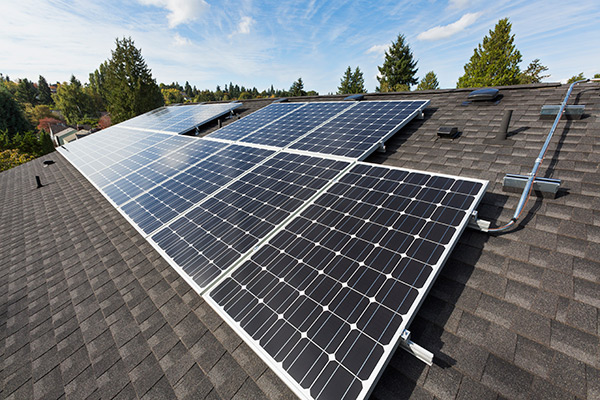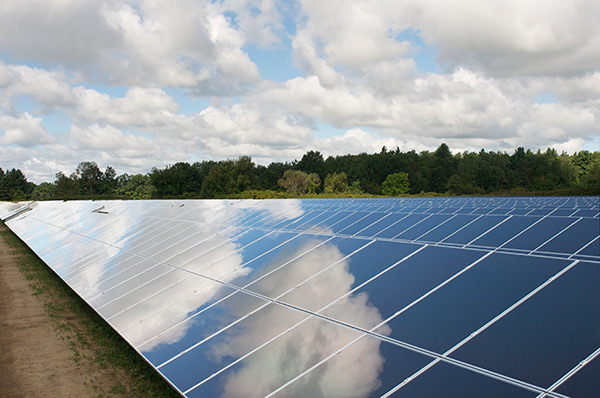ARCHIVED – The Economics of Solar Power in Canada
This page has been archived on the Web
Information identified as archived is provided for reference, research or recordkeeping purposes. It is not subject to the Government of Canada Web Standards and has not been altered or updated since it was archived. Please contact us to request a format other than those available.
Executive Summary

- This report, the Economics of Solar Power in Canada (ESPC), studies the financial viability of typical solar power projects in over 20 000 Canadian communities. ESPC does this by estimating the amount and cost of electricity these projects might generate. It then compares these costs to local electricity prices to understand whether it makes financial sense to install solar. Four types of solar projects were considered: residential, commercial, community, and utility-scale.Footnote 1
- Whether solar generation is competitive in a province or territory often depends more on local electricity prices, rather than the amount of sunlight received.
- Smart metersFootnote 2 could increase the adoption of residential, commercial, and community solar projects, because they help increase the value of electricity generated during the middle of day and improve solar economics. While not every province in Canada has widely deployed smart meters, and no territory has, ESPC estimates solar economics with smart meters across Canada in case smart meters do become widely deployed.
- ESPC estimates solar power economics using three cost scenarios: the cost to install solar now, the cost to install solar in the near future, and the cost to install solar in a low-cost future. Three cost scenarios are considered because solar installation costs have been falling over the long term and are expected to continue falling. As costs fall in the future, break-even prices will continue falling too.
- Some provinces have rebate programs for residential, commercial, and community projects. Because these provincial programs are not always permanent, ESPC does not include rebate programs in the cost to install now scenario. However, when rebates are applied to the cost to install now, they typically result in installation costs that are closer to those in the near future or a low-cost future.
- ESPC uses some basic financial methods, such as considering how much money an alternative investment would make if the money used to install solar was invested elsewhere. This helps to determine a break-even electricity price at which a project owner recovers all their costs. If solar power is installed solely for environmental reasons, its break-even prices would be lower than indicated here, though this may not be a good indicator of whether an owner saves money.
Residential solar highlights:
- Currently, residential solar breakevens are less than residential electricity prices in most places in Prince Edward Island and Saskatchewan. This means that most homeowners there could expect to save money by installing solar. Many homeowners could also expect to save money with residential solar in Ontario, where homes have smart meters capture “time of day” value. Rebate programs in Nova Scotia and in Alberta make current costs more similar to those that would occur in a low-cost future. This means residential solar would be expected to save homeowners money almost everywhere in Nova Scotia. Homeowners in many places in Alberta might save money, but need smart meters.
- Residential solar breakevens are also lower than residential electricity prices in the Northwest Territories and Nunavut. This means that homeowners could expect to save money by installing solar. However, the cost to install solar in the territories is likely higher than assumed in this study because they are remote. Homeowners in Yukon could also expect to save money with residential solar if smart meters are installed in homes.
- In a low-cost future scenario, residential solar is expected to save homeowners money in many Canadian communities.
If you experience slow load times with these Tableau dashboards, you can download the entire packaged Tableau file to your computer. Packaged Tableau Workbook: Solar Results [TWBX 30 MB] You will require Tableau Reader to view the file, which is available to download for free.
Figure ES1: Average residential solar breakevens by province as compared to provincial and territorial energy charges (including other variable costs). Green means solar generates electricity for less cost than purchasing electricity from a utility. Red means solar generates electricity for more than what it costs to purchase electricity from a utility. These are average values and individual communities may be higher or lower than the provincial or territorial average.
Description:
This map shows residential solar breakevens as a percent of residential electricity prices in Canada. Residential solar is currently competitive with residential electricity prices in only a few provinces in Canada. In a low cost future, residential solar is expected to cost less than residential electricity prices in most provinces in Canada.
Open data can be freely used and shared by anyone for any purpose. The data for these graphs are available.
Commercial solar highlights:

- Currently, commercial solar breakevens are less than commercial electricity prices in most places in Prince Edward Island, Nova Scotia, and Ontario. This means that businesses in most places there could expect to save money by installing solar. Businesses could also expect to save money with commercial solar in most places in New Brunswick if smart meters are installed. Rebate programs in Saskatchewan make current costs similar to those in the near future, while rebate programs in Alberta make current costs closer to those in a low-cost future. This means businesses could expect to save money with commercial solar in most places in Saskatchewan and Alberta.
- Commercial solar breakevens are also lower than commercial electricity prices in the Northwest Territories and Nunavut, meaning businesses there can expect to save money by installing solar. However, the cost to install solar in the territories is likely higher than assumed in this study because they are remote. Businesses in Yukon could also expect to save money with solar if smart meters are installed.
- In a low-cost future scenario, commercial solar should save businesses money in many Canadian communities.
Figure ES2: Average commercial solar breakevens by province and territory as compared to typical energy bills. Green means solar generates electricity for less cost than purchasing electricity from a utility. Red means solar generates electricity for more than what it costs to purchase electricity from a utility. These are average values and individual communities may be higher or lower than the provincial or territorial average.
Description:
This map shows commercial solar breakevens as a percent of typical electricity prices in Canada. Commercial solar is currently competitive with commercial electricity prices in several Canadian provinces. In a low cost future, commercial solar is expected to cost less than commercial electricity prices in most provinces in Canada.
Open data can be freely used and shared by anyone for any purpose. The data for these graphs are available.
Community solar highlights:
- Currently, solar breakevens for community projects are less than electricity prices in most places in Prince Edward Island, Nova Scotia, Ontario, and Saskatchewan, meaning that most communities there could expect to save money by installing solar. Communities could also expect to save money with solar in many places in Quebec and Alberta, if smart meters are installed. Rebate programs in Alberta make current costs similar to prices projected in a low-cost future. This means communities could expect to save money with community solar projects in most places in Alberta.
- Solar breakevens for community projects are also lower than electricity prices in the Northwest Territories and Nunavut. This means that communities could expect to save money by installing community solar. However, the cost to install solar in the territories is likely higher than assumed in this study because they are remote. Communities in Yukon could also expect to save money with solar if smart meters are deployed.
- In a low-cost future scenario, community solar would be expected to save money for most Canadians.
Figure ES3: Average community solar breakevens by province and territory, as compared to typical energy bills. Green means solar generates electricity for less cost than purchasing electricity from a utility. Red means solar generates electricity for more than what it costs to purchase electricity from a utility. These are average values and individual communities in each province may be higher or lower than the provincial or territorial average.
Description:
This map shows community solar breakevens as a percent of typical electricity prices in Canada. Community solar is currently competitive with commercial electricity prices in several Canadian provinces. In a low cost future, community solar is expected to cost less than community electricity prices almost everywhere Canada.
Open data can be freely used and shared by anyone for any purpose. The data for these graphs are available.
Utility solar highlights:
- Provincial tariffs—fees that generators pay for costs like electricity transmission—cause utility scale breakevens to be above electricity prices in all provinces and are therefore uneconomic. If no tariffs are applied (e.g, if the electricity is purchased by a third party who pays the tariffs) Nova Scotia currently has a few locations where breakevens are below electricity prices when earning “time of day” premiums. A few locations in Prince Edward Island require “time of day” premiums and trackersFootnote 3 to be installed in order to be economic.
- Utility-scale solar in the Northwest Territories and Nunavut have breakevens below electricity prices, meaning they could save consumers money. However, the cost to install solar in the territories could be higher than assumed in this study because they are remote. Utility-scale solar in Yukon might also be economic if generators receive “time of day” premiums.
- Costs would have to be lower before some places in Saskatchewan become economic. In a low cost future, many places in Canada become economic, although they would still require no, or lower, tariffs.
- Based on assumed installation costs, utility-scale projects with tracking mounts have better economics than utility-scale projects with fixed mounts in Canada. The extra cost to install solar with tracking mounts is more than offset by the increased revenue.
Figure ES4: Average utility-scale solar breakevens by province as compared to provincial wholesale prices or large industry energy charges. Green means solar generates electricity at a lower cost than typical wholesale prices. Red means solar generates electricity at a greater cost than typical wholesale prices. These are average values and individual communities in each province may be higher or lower than the provincial average.
Description:
This map shows utility-scale solar breakevens as a percent of typical wholesale electricity prices in Canada. Utility-scale solar is currently competitive with wholesale prices in only a few provinces. In a low cost future, utility-scale solar is expected to be competitive in about half of the provinces. Utility-scale solar is uncompetitive in all provinces and for all cost scenarios if provincial tariffs are applied.
Open data can be freely used and shared by anyone for any purpose. The data for these graphs are available.
- Date modified:
